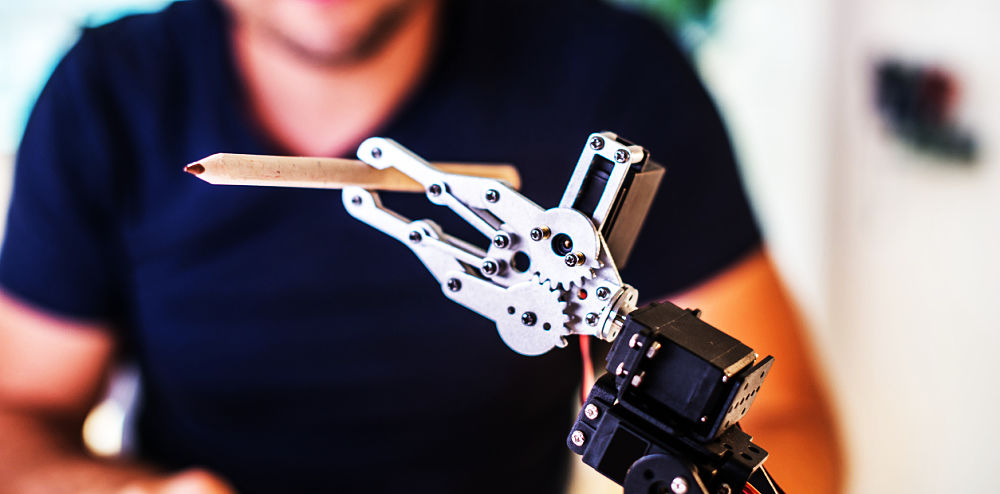Robots and Technology: How It May Affect Your Job and Future

The rise of the robot is changing our world. For some, this raises concerns. People are wondering, “Do I have to worry about a robot taking my job?” According to the consulting firm Pricewaterhouse Coopers (PwC), more than a third of United States jobs are at high risk for automation by the early 2030’s. The firm forecasts that robotic automation in the United States will surpass that of Britain, Germany and Japan. PwC based the prediction on the forecast capabilities of robotics and artificial intelligence (AI). However, they emphasize that there are too many variables to predict the future of this field with certainty.
Advocates believe that robots will create jobs and that the increase in economic productivity will boost the incomes of workers whose skills support the technology. Some U.S. officials believe that robots will help American citizens by enabling them to fulfill more productive roles with higher pay. According to Treasury Secretary Stephen Mnuchin, “We need to make sure we are investing in education and training for the American worker.” Still, Mnuchin expresses, heavy robotic automation in the workplace is more than likely 50 to 100 years away.
The Robots Are Coming! Have No Fear
It’s unclear how robotic technologies will affect the future. There are many variables that could affect how robotics will transform the future. Could we end up becoming docile power supplies used to power world dominating, self-aware drones as portrayed in The Matrix? Probably not – at least not anytime soon. More than likely, robotic technology will accelerate the economy, improve the workplace and take over many low-end, undesirable jobs. The robotic future will demand the skills of talented individuals who can keep intelligent machines running and extend their capabilities.
The probability that robots will take over many manual tasks is real. In fact, this is already evident with innovations such as retail self-checkout kiosks and self-driving trucks. Analysts forecast that as many as 7.5 million retail jobs may succumb to automation over the next decade. Jobs that only require a high school diploma are the most at risk roles for automation. For example, the electronic toll collection firm E-ZPass has already replaced some of its human toll booths with automated systems.
Robots Can Help the Baby Boomers
According to the U.S. Census Bureau, nearly 25-percent of the population will be age 65 or older by the year 2060, increasing the demand for health care services. Robots could help by taking over repetitive tasks such as reminding patients to take medication and helping with exercises.
Though the trend will probably take some getting used to. Artificial intelligence (AI) powered smart machines could one day help health care professionals improve organizational performance and quality of service. Robotics, along with other advances, such as big data systems and machine learning, could help to improve the overall health of the population. Tomorrow’s nurses may find some of their most helpful peers are man-made, robotic innovations.
Around the world, researchers are searching for ways to use robots to manage the growing health care talent shortage. The robots help health care professionals with medical tasks such as checking vital signs and patient statuses, and more. Some care giving agencies have implemented robotic assistants to help clients with interactive tasks. In hospitals, pharmacological robots can dispense prescriptions, while others can perform tasks such as disinfecting surfaces.
The Future of Robotics
Advancements will continue to emerge in the robotics field. It’s a safe bet that the technology will do more good than harm. Before this happens, there are several areas where robotic technologies need to advance. For now, the next horizon for robotics engineers is to improve the ability of robots to communicate, especially for surgical applications. Researchers are also working on improving robotics technology that already mimics human movement with 70-percent accuracy. Other researchers are working on improving human-robot interaction, and while engineers have developed robotic technologies that effectively perform basic tasks, they must improve the ability of robots to engage with humans before the innovation can make a significant contribution to helping with the health care talent shortage.
Despite current shortcomings, robotics technology is useful in the medical field. Once researchers improve the capabilities of robots, health care professionals will have more time to engage with patients, and the abilities of surgeons to perform minimally invasive procedures will improve. The technology will have a positive impact on many aspects of the health care field. As robotics technology advances, health care professionals will need to learn new skills to make the most of their automated counterparts.



